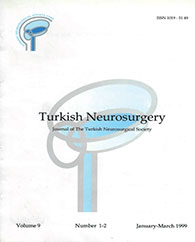Turkish Neurosurgery
1999 , Vol 9 , Num 1-2
ANTERIOR OR POSTERIOR INSTRUMENTATION IN THE TREATMENT OF UNSTABLE THORACOLUMBAR FRACTURES: A RETROSPECTIVE ANALYSIS OF 30 CASES
Çukurova University, School of Medicine, Department of Neurosurgery, Adana, Turkey
Surgical procedures designed to decompress and stabilize unstable trauma-related thoracolumbar fractures are primarily anterior or posterior operative approaches combined with anterior or posterior instrumentation. Our goal is to identify patients that are likely to benefit from either fixation system. Two treatment groups were studied. The first group of 20 patients underwent posterior instrumentation and fusion. Also, eighteen patients with evidence of neural compression were treated with posterior decompressive surgery. The second group, consisting of 10 patients with neurological deficits, was managed with single-stage anterior decompression, interbody strut grafting, and anterior instrumentation. There were no statistically significant differences between the groups with regard to postoperative neurological outcome (Mann-Whitney U, P>0.05), pain assessment and ability to return to work (Ch isquare, P>0.05), rate of instrument failure (Chi-square, P>0,05), rate of solid fusion (Chi-square, P>0,05) and loss of reduction (Mann-Whitney U, P>0.05). When surgery is indicated, the operative approach (anterior or posterior) and type of instrumentation used (anterior or posterior) are determined by the location and characteristics of the fracture kg., neural compression and instability) and the surgeon's familiarity with the various techniques. Based on the results of this study, we conclude that posterior spinal instrumentation is as effective as anterior instrumentation in the treatment of unstable thoracolumbar fractures.
Keywords :
Fusion, instrumentation, stabiIization, thoracolumbar fractures





